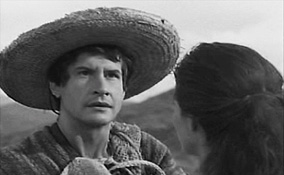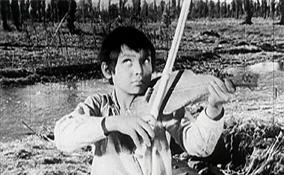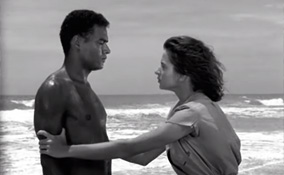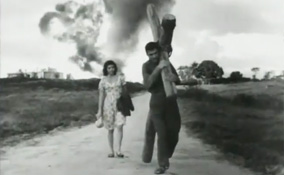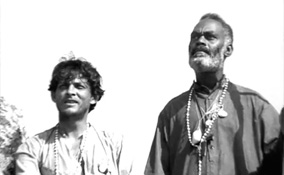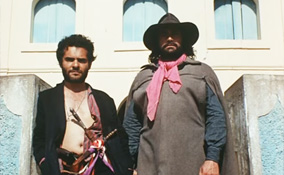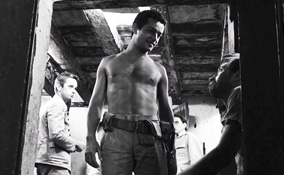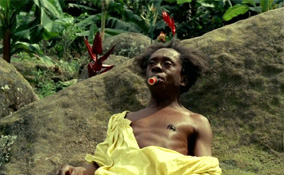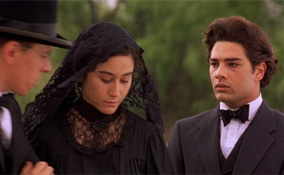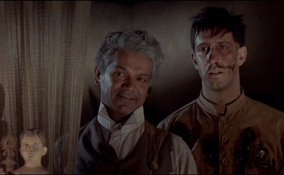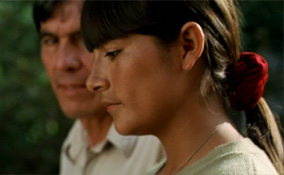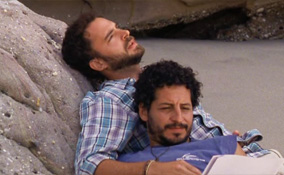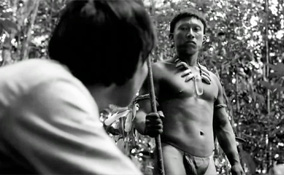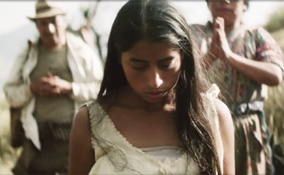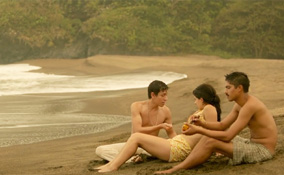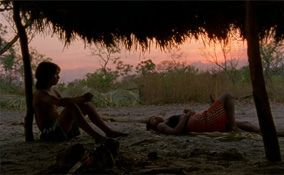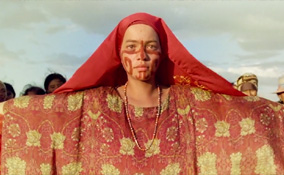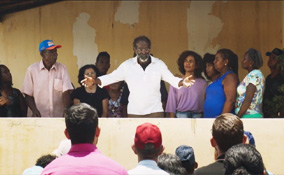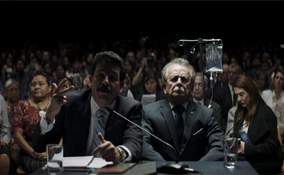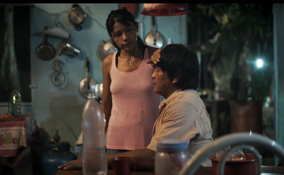<<< II
Notes on magical-realist films from Latin America Magical Realism is neither folklore, fairy tale, fantasy nor surrealism. It is first and foremost "realist" story but with some magical elements. For academics, magical realism exclusively involves with politics of Latin America where "realism" was influenced by arrival of European colonizers (who came from Renaissance period), with natives' "magical" elements tried to breakthrough realist narrative.
Latin-American cinema, like other Third World cinema, started with mainstream escapist films largely influenced by American Western genre. After capitalist populism and dictatorships, came socialist movement in 1950s that helped creating new wave cinema emphasizing on social problems, marginal cultures and beliefs which led to magical realism, and crazier surrealist films in the time of military dictatorships (some of them with US interventions).
"We've got to be nicer with the dead because we spend more time dead than alive"... Watching rich families offering turkeys to the dead during Day of the Dead festival, poor wood-cutter Macario vowed not to eat anything until he could have a whole turkey for himself alone. He would later be interrupted by Devil, God and Death in this Mexican masterpiece Macario (1960, Roberto Gavaldón, Mexico)***. When Macario got miraculous water that could cure every diseases, the story escalates into battles between locals and inquisitors, superstition and colonizer's Christianity, and finally between classes of Mexican origins and European descendants in 18th century Mexico. In an indigenous village of Mexico, there was a boy with extraordinary ears that's hypersensitive to sound. He met an old man who taught him how to play violin properly. After the old man died, the boy's music had reached the point that it could move human and animals, to tears or to fear. This music scared people and they thought it's sound of devils. Yanco (1961, Mexico)*** is excellent film with very little dialogue, almost only sound of nature and music. I found the ending quite a shock, especially for children film. And I'm not sure if this was intended to be interpreted as metaphor: during carnival full of indigenous music and native dancing, the boy risked his life sneaking out in the dark to play violin - which is European instrument - and this will finally lead to something tragic!
There's a fishing village in Brazil, living there descendants of African slaves brought here by European colonizers. Herein this lowest of lower classes in colonial caste system, they're still practicing African mysticism. One educated man came back to the village, with bad intention, condemned superstitions and started destroying the whole community. The Turning Wind (1962, Brazil)** [watch] is obviously political film exploring collapse of traditional self-sufficient life and becoming cheap labors in capitalist world. This was the first film of Glauber Rocha, who was praised as the greatest Brazilian filmmaker of all time. He and his friends started Cinema Novo movement in 1960s Brazil that changed landscape of Latin-American cinema. A poor Brazilian farmer made a promise to an African god (brought here by African slaves) that he would carry the cross to Saint Barbara church. His ideological argument with tough-minded Catholic vigar was blown up by newspaper into some kind of socialist revolution. Adapted from a play, The Given Word (1962, Anselmo Duarte, Brazil)**** [watch] is an excellent film exploring almost every conflicts possible in Latin America. Shot in style of Italian neorealism and won Cannes' Golden Palm, this film was surprisingly excluded from Cinema Novo movement because its director originally came from studio system.
A poor cowherd Manuel killed his employer and fled to join a pilgrimage led by a black man claiming to be Saint Sebastian. The group turned into extreme Christian cult. The church and establishment found themselves lost popularity to Saint Sebastian, so they hired a hitman Antonio das Mortes to kill him. Black God, White Devil (1964, Brazil)*** [watch part one, two] is the first film in Glauber Rocha's trilogy. The first-half of the film (Black God) is obviously criticism of capitalism and religion. The second-half (White Devil) becomes stranger and messier when narrative unexpectedly changes to Western genre on acid. This part goes on opposite way to criticize anarchists and anti-government rebels. This radical filmmaking of 25-year-old director was very influential to Brazilian cinema at that time.
A poor village in Northeastern Brazil facing drought, people were praying to a holy ox for rain to come. A group of white-skinned soldiers was sent there to protect food storage of a politician from starving people. When a man was shot dead, situation got out of control. The Guns (1964, Ruy Guerra, Brazil)*** is slow-burn film that will explode in the end. Very good for what it's supposed to be, especially the last scene. Macunaima was born as adult black man from a drag queen mother. Sometimes he turned into handsome white man but still with childish behaviors. Adapted from Modernist novel, Macunaima (1969, Joaquim Pedro de Andrade, Brazil)* makes fun of almost everything from indigenous folklore, poverty, racism, anarchism, terrorism, capitalism, morality to Brazil itself and reduces them into something ridiculous. Most of the time silly and annoying, but this chaotic surreal film might work as crazy reaction to Brazil's military dictatorship at that time.
In 1594 Brazil, there were disputes between two cannibal tribes: Tupinambas (supported by French army) and Tupiniquins (supported by Portuguese army). A Frenchman was captured by Tupinambas tribe who mistook him for a Portuguese. They treated him as slave and provided him a wife, until the day of ceremony that he would be eaten. Based on real story of German explorer, How Tasty Was My Little Frenchman (1971, Nelson Pereira dos Santos, Brazil)**** [watch] is unusual comedy that sometimes I need to remind myself that it is a comedy. Watching natives through the lens of European realist perspective, you (and the protagonist) would realize that these people had different mindset in different time, and it's very cruel. The filmmaker, the grandfather of Cinema Novo, was so brave to use costumes as real as in history which couldn't cover anything at all. Gabriel was gifted by African voodoo a shielded body that could protect him from any weapon. When he grew up he joined a gangster. The first hour of The Amulet of Ogum (1974, Nelson Pereira dos Santos, Brazil)* is promising but the whole film is too long with too many silly moments and plot-holes, even for supernatural story. I'm not sure if this was dos Santos' experiment or a kind of satire, I just couldn't believe it's the same director who made important ultra-realist film Barren Lives (1963)*** [watch].
Dona Flor's good-for-nothing husband unexpectedly died, she later married a boring pharmacist. But the ghost of her first husband came back, naked, to fulfill her sexual desire in sex comedy Dona Flor and Her Two Husbands (1976, Bruno Barreto, Brazil)**. When things get complicated Dona Flor seeks help from African witchcraft to drive him back to afterlife. Though behaviors of macho first-husband were almost unbearable, this delightful sex-fantasy film was the most successful film in Brazil for over twenty years. 1895 before Mexican Revolution (1910-1920), Tita was born the youngest daughter in family which traditionally had to take care of her mother until she dies. Her magic power worked with foods by transferring her feelings to everyone who has them: melancholy, lust, anger or love. Though in love with Pedro, her mother won't allow her to marry him, so Pedro decided to marry Tita's older sister instead. Globally famous Like Water for Chocolate (1992, Alfonso Arau, Mexico)** is bittersweet, romantic and nostalgic tale that spans through many generations and many turns of events, in already established style of Gabriel García Márquez's magical-realist novel. This film might be the one that set the tone for expensive magical-realist films to follow.
International production with Danish director in English language film, The House of the Spirits (1993, Bille August)** adapted from Isabel Allende's book tells story of Clara
(Meryl Streep) who was born with supernatural power in wealthy family in Chile, and Esteban
(Jeremy Irons) who worked hard to become ranch owner and later Chilean conservative politician. They were parents of rebellious children in the world that was changing before their eyes. The last act of the story involves aftermath of 1973 violent military coup in Chile, with US intervention. This decent film is tedious and too clinically clean with almost entirely white-skinned cast, it doesn't feel like Latin-American film at all but it works in its own way in the end. This is what happens when you have European realist filmmaker adapting Latin-American supernatural book, it lacks magic moment. The Citrillo's Turn (2005, Felipe Cazals, Mexico)* is metaphors about situation before Mexican Revolution (1910-1920) which I couldn't get anything at all. Every character is also really unlikable.
In terrorism period Peru (1980-2000), mothers who were raped, transferred fear and sadness to their children through breast milk, this was called Milk of Sorrow (2009, Claudia Llosa, Peru)*. Learned from her mother, Fausta put a potato in her vagina hoping to prevent rape, even though Peru had already passed that period for a long time. Now the potato's roots grow and spread into her womb. There are some good moments in this Berlin's Golden Bear winner, but some other times seriously need explanations. Weird behaviors with illogical mindset, I don't know how this woman can survive this long. It doesn't make any sense. White-skinned director making film about crazy indigenous woman sounds very exploitative, this is also the case of her previous film, Madeinusa (2006)* where the whole village went crazy except one and only white-skinned stranger in town. In contrast to other magical-realist films, both films above present indigenous beliefs as something harmful and useless, and should be eliminated from civilized societies. In a seaside village in Peru, a married fisherman, Miguel, had a secret male lover, Santiago. When Santiago died and his body stuck under the sea, his spirit stayed in this world and could not go to the afterlife. Since no one can see Santiago except Miguel, now they can enjoy being together in public without fear. Miguel will finally meet his dilemma - should he help liberating Santiago's soul to rest in peace, or let Santiago stuck here with him forever? Undertow (2009, Javier Fuentes-León, Peru)*** is very lovely and charming with many layers underneath.
Two separate stories of two white men on journeys to find a sacred plant 30 years apart depicted in Embrace of the Serpent (2015, Ciro Guerra, Colombia)***. In 1909 a sick white scientist was brought to a shaman who told him that only yakruna could save his life. In 1940 another white man came to the same shaman looking for the legendary plant. Both of them witnessed several painful events of rubber plantations in colonial period along their expeditions. The 30-year time gap makes it even sadder. Very good film with striking cinematography. Maria was expected to marry the widow Ignacio, but she had her boyfriend Pepe. When Pepe told her his plan to illegally move to the US, she decided to sleep with him hoping he will take her with him. Ixcanul (2015, Jayro Bustamante, Guatemala)** explores Kaqchikel culture in Guatemala, they live their daily lives paying respect to volcano as deity. Meanwhile snakes had roamed in their farm, they tried to chase them with US chemicals (science) and superstition, before things turned out worse. Interesting details but a bit pretentious. Anyway if I were a member of this Mayan tribe, I would feel offended by this film.
A white-skinned linguist tried to record a dying language, Zikril, the language that could communicate with animal kingdom. But there were only two old men alive that could speak Zikril. Both men hated each other so much, they hadn't talked to another for 50 years. There was rumour that's because both men fell in love with the same woman. I don't think it's spoiler since anyone wants to see this film must already know that I Dream in Another Language (2017, Ernesto Contreras, Mexico)**** is actually a queer love story. What use of a language if they won't talk to each other? This film is about love, fear and redemption in the last breath of the language that will disappear forever. In indigenous territory, Ihjãc was called by his dead father to a waterfall. His father told Ihjãc he forgot to offer him funerary feast. Ihjãc found out later that this ability to connect to the dead destined him to be a shaman. But he didn't want to be one, so he decided to leave the village and went to town. The Dead And The Others (2018, Renée Nader Messora, João Salaviza, Brazil)** is beautiful with interesting story but very pretentious. It falls in category of pretentious art films which usually show people acting unnaturally and unemotionally like robots, without any good reason.
From the director of Embrace of the Serpent, Birds of Passage (2018, Cristina Gallego, Ciro Guerra, Colombia)***
chronicles origins of drug trafficking in Colombia between 1968-1980. According to this film it all began with marijuana trade from indigenous tribe to American hippies. When money came there would be violence, betrayal and revenge, then Birds of Passage turned to be gangster movie in the end. Simple and effective tale about battle of old traditions and modern greed until the line between them finally blurred. The controversial question from this film is that - were these tribal traditions the one that make drug violence worse? The answer is yes. And in the end there will be no tradition left. A dam was blocked by a politician. No water flows to village Bacurau (2019, Brazil)*. This acclaimed Brazilian genre-bending film opens like a supernatural drama then suddenly turns to sci-fi in second hour with one-dimensional bunch of villains talking silly dialogues while reimagining colonial brutalities. It represents the clash of two genres/cultures between supernatural/natives and sci-fi/colonizers. Still disappointing.
Latin America's most famous folklore, La Llorona, or The Weeping Woman, tells story of an indigenous woman who had two children with a Spanish conquistador. When she saw him with other woman, she drowned her children in a river with anger. Consumed by guilt, she drowned herself too. Her spirit then has to roam the earth until she finds her children again. In this Guatemala's film version, La Llorona (2019, Jayro Bustamante, Guatemala)* is about retired military general who is on trial of genocide of indigenous Mayan tribe in 1980s. He starts hearing sound of woman crying. When situation gets worse with crowds of protestors around the house, then comes a new maid from deep Amazon forest. Boring and predictable. Fish-out-of-water tale of an indigenous man working as security at a harbor. He told a story to his grandson about a hunter who was taken by monkeys to enchanted world, and was sent back by another monkey. When he heard calls from nature he started having fever. The fever, cracked wall or mysterious animal - everything in The Fever (2019, Maya Da-Rin, Brazil)*** is metaphor for natural world of indigenous people that he left behind, and the protagonist's desperate longing to return to the old world. The film also unsubtly attacks white-skinned people as the one who destroyed their paradise.
|
||
++++++++
Other Latin-American films I watched recently: The Deceased (1965, Leon Hirszman, Brazil)** Birdwatchers (2008,
Marco Bechis, Brazil)***
Read Further:
Posted: October 2022
<<< II
|
||
 |
||
